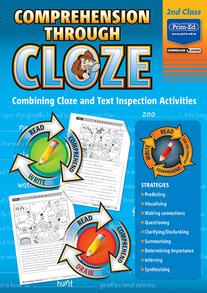-
0
Your cart is currently empty.
-
0
Your cart is currently empty.
Cloze Procedure & Exercises
Reading comprehension underpins children’s understanding of language, so it’s essential to engage them with exercises that will help them learn this skill.
We offer a wide range of products based on cloze procedure to inspire children and help them master reading comprehension, the cornerstone of their education.
Why is reading comprehension important?
Reading comprehension is one of the most important skills that children develop throughout their primary education and beyond.
Mastering reading comprehension enables children to decode and understand any text, passage or other types of information for themselves. While it is primarily applied to understanding language, reading comprehension skills can also be transferred to decipher mathematical or scientific information, for example.
For the most effective way to practise reading comprehension, choose exercises that stimulate children to engage in the text and think for themselves. One such exercise is cloze procedure.
What is a cloze procedure?
A cloze procedure or exercise is a reading comprehension activity where children choose a word from a list or bank to complete the blanks. The gaps will occur at regular points throughout the text.
It’s different from a gap-fill exercise because cloze procedure tests a wider range of skills, whereas gap-fill activities focus on one particular aspect of language, such as practising using conjunctions or a tense.
What are the benefits of a cloze procedure?
Using a cloze procedure will test and reinforce a wide range of literacy skills. Instead of simply focusing on one grammatical point, a cloze exercise requires children to put their grammar, spelling and overall language to use all at once.
Children will also need to look for context clues and understand the overall meaning of the passage to be able to choose the right words and practise a whole range of skills, including visualising, predicting and inference.
Integrate cloze techniques throughout the school with our resources
Children can benefit from cloze techniques from 1st Class onwards. Choose articles that appeal to each individual class. Our Comprehension Through Cloze series is tailored for each class level.
The range features:
- Reading passages with incomplete illustrations for children to fill in.
- Illustration-based cloze exercises.
- Focus pages on comprehension strategies.
Our Cloze Encounters series features cloze exercises in PDF form, which teachers can photocopy and distribute during lessons. Children will love the topics and themes that stimulate their learning.
The Big Book of Cloze range brings together activities from a previously published series to develop children’s reading and comprehension skills.
And our Cloze in on Language series offers a literacy package for use across the school with exercises that can be photocopied, teacher information page and answers included.
Frequently Asked Questions
Why choose cloze exercises over gap-fill exercises?
While gap-fill exercises are useful to test a specific point of grammar, a cloze procedure demands broad knowledge of language. It stimulates children in many different ways and deepens their understanding of language.
At what age can children practise cloze exercises?
Our range is aimed at children from 1st Class onwards, with age-appropriate exercises to help develop emerging skills.
Can cloze exercises be used for children of all ages?
Yes, our range of cloze procedure materials caters for children throughout their primary school lessons.
How can I help my pupils get the most from cloze exercises?
Encourage your pupils to try these useful tips:
- Read through the entire text before choosing individual words.
- Read through the words provided and check if they understand them.
- Think grammatically: does the space need a verb, adjective or noun?
- Allow them to use a pencil so they can review and rub out their original answer if they change their mind.
- Start filling in the blanks they’re most confident with first.
- Once the exercise is finished, read it back to check if it makes sense.



















